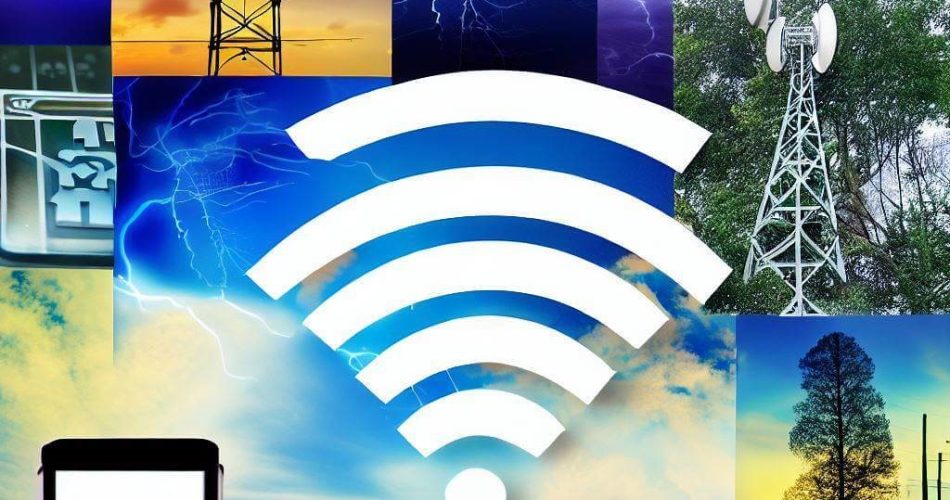Introduction
In today’s world, we are surrounded by devices and technologies that make our lives easier and more convenient. However, these advancements often come with their own set of questions, primarily concerning their safety and impact on health. One of the most talked-about topics in this context is Electromagnetic Fields (EMF) and their potential link to radiation. What is EMF, and how does it connect with radiation? Understanding this “unseen link” may be essential for our well-being and future. Let’s dive into this comprehensive guide to grasp these somewhat complicated but incredibly relevant topics.
Definition of EMF
Electromagnetic Fields (EMF) are invisible zones of energy that surround electrically charged objects. While the term might sound like something out of a science fiction novel, EMFs are actually a natural part of our world. They emanate from the earth, the sun, and even the human body. But they are most commonly known for their role in modern technology.
Brief Explanation of Radiation
Radiation refers to the emission or transmission of energy in various forms such as waves or particles. Radiation can come from natural sources like the sun or from man-made objects like X-ray machines. Although the term often has a negative connotation, not all forms of radiation are harmful.
Importance of Discussing the Unseen Link
There is growing interest in understanding the possible link between EMF and radiation, particularly with the proliferation of electronic devices that emit these fields. The aim of this article is to explore this link from various angles, including scientific evidence, pros and cons, and protective measures, to equip you with the knowledge you need to make informed decisions.
Types of EMF
Understanding the different types of Electromagnetic Fields is the first step in appreciating their potential impact on our lives and health. EMFs can generally be divided into three main categories: Electric Fields, Magnetic Fields, and Electromagnetic Radiation.
Electric Fields
Electric fields are generated whenever voltage is present. These fields exist even when there is no current flowing. For instance, if you have a lamp plugged into a socket, an electric field will be present around the plug and the wire, whether the lamp is turned on or off. These fields are easiest to find near high-voltage electrical lines and transformers. Electric fields can be shielded or blocked by objects like walls or trees.
Magnetic Fields
Magnetic fields are produced by the movement of electric charges, meaning they are created when there is current. For example, when you turn on that lamp mentioned earlier, a magnetic field is produced around the wire carrying the electricity to the bulb. Magnetic fields are commonly produced by items like electric motors in household appliances, power lines, and even some industrial machinery. Unlike electric fields, magnetic fields are not easily shielded and can pass through most objects, including walls.
Electromagnetic Radiation
Electromagnetic Radiation is perhaps the most commonly discussed type of EMF, especially in the context of wireless communications like cell phones and Wi-Fi. This category includes radio waves, microwaves, infrared radiation, visible light, ultraviolet radiation, X-rays, and gamma rays. The energy carried by electromagnetic radiation is what potentially connects it to health concerns, which is why it’s crucial to understand how it works and how we interact with it daily.
Sources of EMF
Understanding the origin of Electromagnetic Fields can help us make informed decisions about our interactions with technology and the environment. EMF sources are broadly categorized into Natural Sources and Man-made Sources.
Natural Sources
The Earth itself is a source of magnetic fields; its core behaves like a giant magnet. The Earth’s magnetic field is what allows compasses to point north and plays a significant role in navigation.
- Solar Radiation: The sun emits a wide range of electromagnetic radiation, including visible light and ultraviolet rays. Exposure to natural sunlight is how our bodies synthesize vitamin D.
- Human Body: Our own bodies produce weak electromagnetic fields. For example, the heart and brain operate with a complex set of electrical signals.

Man-made Sources
- Mobile Phones: According to a report by the World Health Organization, mobile phones emit radiofrequency fields that are a form of non-ionizing radiation.
- Wi-Fi Routers: Similar to mobile phones, Wi-Fi routers also emit radiofrequency fields. However, these are typically at a much lower level than that of mobile phones.
- Home Appliances: Devices like microwaves, TVs, and even vacuum cleaners generate EMFs, primarily in the form of electric and magnetic fields.
According to a study published in the Environmental Health Journal, the increase in man-made EMF sources over the last century has led to growing concern about potential health impacts.
Radiation Types
Radiation is not a one-size-fits-all term. It encompasses a spectrum of types that can be grouped mainly into Ionizing Radiation and Non-Ionizing Radiation.
Ionizing Radiation
This form of radiation has enough energy to remove tightly bound electrons from atoms, turning them into ions. Examples include X-rays and gamma rays.
- Medical Applications: X-rays are widely used in healthcare for diagnosing internal body structures.
- Nuclear Reactions: Gamma rays are produced during nuclear reactions, both natural and man-made.
According to the Environmental Protection Agency (EPA), ionizing radiation is a proven human carcinogen.
Non-Ionizing Radiation
Low-frequency radiation that doesn’t have enough energy to ionize atoms. Examples include radio waves, microwaves, and visible light.
- Telecommunications: Radio waves are extensively used in broadcasting and telecommunications.
- Daily Appliances: Microwaves are used in various everyday appliances like ovens.
Health Implications
The health implications of EMFs have been a topic of much research and debate. While conclusive evidence is lacking, various studies point in different directions.
Scientific Studies
- Possible Health Risks: Some research, including a study by the International Agency for Research on Cancer (IARC), suggests that exposure to high levels of EMF could potentially lead to health risks like leukemia in children.
- Contradictory Evidence: On the flip side, other studies, such as those cited by the National Cancer Institute, suggest there is no consistent evidence linking EMF exposure to cancer.
The Ongoing Debate
- Lack of Consensus: There is still no consensus within the scientific community on the health implications of EMF exposure.
- Precautionary Approach: Due to the lack of conclusive evidence, some health bodies recommend a precautionary approach, which includes measures like using hands-free devices or texting instead of calling when using mobile phones.
A report from the World Health Organization states that current evidence does not confirm the existence of any health consequences from exposure to low-level electromagnetic fields. However, some individual studies suggest that they could pose a risk, leading to ongoing research.
Pros and Cons of EMF
The subject of Electromagnetic Fields (EMF) is not black and white; it has both advantages and drawbacks. By understanding these, we can better navigate the technological landscape and perhaps minimize any associated risks.
Pros
Technological Advancements
EMFs are indispensable in our modern, connected world. They make wireless communication possible, which includes everything from mobile phones to Wi-Fi.
Medical Applications
Certain types of EMF are used in medicine, like the radiation in X-rays and MRIs, for diagnostic purposes and even some forms of treatment.
Convenience and Efficiency
From household appliances to industrial machinery, EMFs make our lives more convenient and our work more efficient.
According to a study published in the Journal of Radiological Protection, certain EMFs are necessary for some medical treatments to work effectively.
Cons
Health Risks
While the jury is still out, some studies suggest potential health risks from high levels of EMF exposure, such as an increased risk of certain cancers.
Electrosensitivity
Some individuals claim to suffer from a condition known as Electromagnetic Hypersensitivity (EHS), where they experience symptoms like headaches and fatigue when exposed to EMFs, although this is not universally recognized by the medical community.
Environmental Impact
High levels of EMF may have ecological implications. For example, studies have indicated that EMFs can affect bird migration patterns.
EMF and Daily Life
The omnipresence of EMF technology in our day-to-day lives calls for a closer look at how it impacts us, from our homes to our workplaces.
Home Environment
Appliances and Gadgets
From microwaves to vacuum cleaners and smartphones, various appliances and gadgets in our homes emit EMFs.
Wi-Fi Networks
Our home Wi-Fi networks are a constant source of radiofrequency electromagnetic fields.
Workplace
Office Equipment
Computers, photocopiers, and Wi-Fi networks in the office also emit EMFs.
Industrial Exposure
People working in certain industries may be exposed to higher levels of EMF due to machinery and other technological applications.

Public Spaces
Transportation
Public transportation options like trains and buses often have Wi-Fi networks and are thus sources of EMF.
Urban Infrastructure
In smart cities, EMFs are emitted from various sources like traffic lights, digital signages, and surveillance systems.
A study published in the Journal of Exposure Science & Environmental Epidemiology indicates that we are exposed to varying levels of EMFs throughout the day, depending on our location and the activities we are involved in.
Protection Measures
Navigating the world of electromagnetic fields (EMF) requires some caution, given the uncertainty about their long-term effects. There are several steps you can take to protect yourself and minimize potential risks.
Distance is Your Friend
Keeping Devices Away
The intensity of the electromagnetic field decreases as you move farther away from the source. Simple steps like keeping your mobile phone away from your body when not in use can help.
Avoiding High EMF Zones
Places near power lines or industrial machinery often have stronger electromagnetic fields. Maintaining distance from these areas can minimize exposure.
Shielding and Grounding
EMF Shielding Materials
Materials like lead can shield ionizing radiation, while other specialized materials can protect against non-ionizing radiation.
Grounding Electrical Devices
Proper grounding can reduce the electric field emissions from devices and appliances.
According to the National Institute for Occupational Safety and Health (NIOSH), shielding and grounding are effective methods to control static and low-frequency electrical hazards.
Legal and Regulatory Aspects
As EMFs become increasingly prevalent, governments and organizations have begun to step in, offering guidelines and regulations to manage potential risks.
International Guidelines
World Health Organization (WHO)
The WHO has released guidelines regarding safe levels of exposure to various types of EMFs.
International Commission on Non-Ionizing Radiation Protection (ICNIRP)
This body provides guidelines for exposure limits for electromagnetic fields that are not ionizing.
National Regulations
Federal Communications Commission (FCC)
In the United States, the FCC regulates communication devices that emit radiofrequency radiation, ensuring that they meet safety guidelines.
European Union Directives
In Europe, various directives aim to protect workers from electromagnetic field exposure.
Several countries, including some in Europe, have restrictions or bans on Wi-Fi in schools to reduce children’s exposure to EMFs.

Future Trends
As technology continues to evolve, so does our relationship with EMFs. Looking ahead, several trends could shape how we interact with these fields.
5G Networks
Increased EMF Exposure
The rollout of 5G is set to increase the number of EMF-emitting devices, raising questions about its potential health impact.
Research on Health Effects
There is ongoing research to determine the safety of 5G EMF emissions.
IoT Devices
Proliferation of Devices
The Internet of Things (IoT) involves connecting everyday devices to the internet, which will result in more devices emitting EMFs.
Concerns and Safety Measures
The proliferation of IoT devices is expected to lead to more comprehensive safety guidelines.
According to the International Journal of Environmental Research and Public Health, the deployment of 5G networks could result in involuntary exposure to electromagnetic fields, leading to public health issues if not properly managed.
Unlocking The Mystery: A Summary
The subject of electromagnetic fields (EMF) is complex and rife with both potential and concerns. Throughout this article, we’ve explored various facets of EMFs—from their sources and types of radiation to the legal frameworks governing their use. The goal has been to provide you with a comprehensive overview that helps demystify this often misunderstood phenomenon.
Balancing Pros and Cons
We have looked at the significant benefits of EMFs, such as technological advancements and medical applications, as well as the downsides like potential health risks and environmental impact.
Everyday Exposure
We examined how EMFs are an integral part of our daily life, be it at home, work, or public spaces, and discussed the varying levels of exposure based on location and activity.
Staying Protected
Lastly, we delved into the precautions one can take to minimize exposure and looked into the existing legal frameworks and emerging trends.
FAQs
1. Are EMFs harmful?
While some studies suggest potential health risks, such as an increased risk of certain cancers, from high levels of EMF exposure, no scientific consensus confirms EMFs as harmful. Ongoing research aims to provide more definitive answers.
2. What are some ways to reduce EMF exposure?
Distance from the EMF source, shielding, and grounding are effective ways to minimize exposure. For instance, keeping mobile phones away from the body when not in use can reduce exposure.
3. Do all electronic devices emit EMFs?
Most electronic devices emit some form of EMF, but the levels and types can vary. Devices like mobile phones and Wi-Fi routers emit radiofrequency fields, a form of non-ionizing radiation.
4. Are there legal limits on EMF emissions from devices?
Yes, organizations like the Federal Communications Commission (FCC) in the U.S. and corresponding bodies in other countries set limits on EMF emissions from various devices, including mobile phones.
5. What is the future of EMF technology?
The future is likely to see an increase in EMF-emitting devices, especially with the rollout of 5G and IoT technologies. However, this is expected to be accompanied by more comprehensive safety guidelines and ongoing research into potential health effects.

